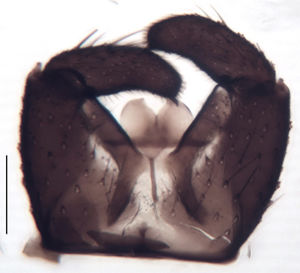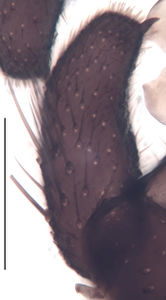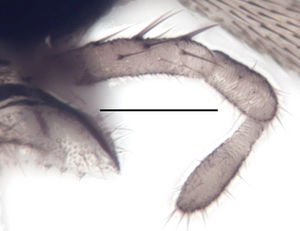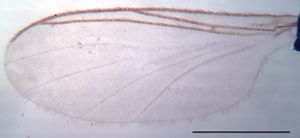Trichosiopsis saltuum
Ordo: Diptera
Familia: Sciaridae
Genus: Trichosiopsis
Name
Trichosiopsis saltuum (Winnertz, 1868) – ZooBank link
- Sciara saltuum Winnertz, 1868[1]: 534–435
Type material
Lectotype ♂ no. 0085, leg. Nowicki, in ZMJU
Type locality
Poland, Tatra
Material studied
Austria: 1 ♂, Gesäuse Nationalpark, Quelle in Saugasse an Forststraßenkehre, HYK teils überschüttet, emergence trap, Gerecke, 12.06.2010, PKHH 7766; 1 ♂, Quellfassung West (Unteres Rohr), sweep netting, Haseke & Remschak, 29.05.2013, PKHH 8280; Finland: 2 ♂ Kb, Koli, Pielisjärvi, grassy birch forest at former slash and burn site, sweep netting, Jaschhof, 10.06.2004, PKHH 6235; Germany: 2 ♂, Bavaria, Nationalpark Berchtesgaden, Seelein-See, sweep netting, Gerecke, 01.07.2013, ZFMK 1548; 1 ♂, Ruhpolding, Rauschberg, Almwiese, sweep netting, Heller, 26.06.2012, ZFMK 199; 1 ♀, Sankt Oswald-Riedlhütte, Malaise trap, Sellmayer, 4.-18.05.2012, ZSMC 2570; 8 ♂, Rhineland-Palatinate, Gönnersdorf (Eifel), Mäuerchenberg Trockenrasen, Malaise trap, Cölln, 25.5.-01.06.1991, PKHH 1864; 1 ♂, Saxony-Anhalt, Rübeland, Kaltes Tal, Bergwiese mit einzelnen Fichten und Birken, sweep netting, Heller, 09.06.2001, PKHH 3447; Italy: 8 ♂, Stilfzer Joch NP, Suldental bei Schmelz, hochmontaner Fichten-Lärchen-Wald, Malaise trap, Lange & Ziegler, 11.-27.06.2005, SDEI 2804–2811; 32 ♂, Suldental bei Schmelz, montaner Fichtenwald, Malaise trap, Lange & Ziegler, 31.5.-11.06.2005, SDEI 2714–2045; Norway: 3 ♂, Sogn og Fjordane, Lærdal, Eråksdalen, Birkenwald und Almvegetation, sweep netting, Heller, 04.06.2014, PKHH 8439; 2 ♂, Luster, Gsesingane, Birkenwald an Baumgrenze, sweep netting, Heller, 05.06.2014, PKHH 8420; 3 ♂, Vestfold, Larvik, Mølen, Sanddüne, Malaise trap, Gammelmo & Olberg, 30.4.-01.06.2009, PKHH 8501; Sweden: 2 ♂, Bohuslän, Ödsmal, Västra Götalands län, Hällsberget, broad leaved deciduous forest, Malaise trap, Swedish Malaise Trap Project, 24.4.-25.05.2004, PKHH 5835, NHRS 971 [as Leptosciarella tochanterata[2]]; 4 ♂, Småland, Bäckebo, Kalmar Län, Grytsjöns naturreservat, Old aspen forest in boulder terrain, Malaise trap, Swedish Malaise Trap, 21.4.-18.05.2006, PKHH 7310.
DNA Barcoded material
| Stadium | Country | Province | Locality | Habitat | Method | Date | Collector | Collection Number | Collection |
|---|---|---|---|---|---|---|---|---|---|
| 1 ♀ | Norway | Telemark | Ovre Gunleiksrud Eng E garden | Malaise trap | 16.06.2014 | S. Reiso | bf-sci-01142 | NHMO | |
| 1 ♀ | Norway | Telemark | Ovre Gunleiksrud Eng E garden | Malaise trap | 16.06.2014 | S. Reiso | bf-sci-01136 | NHMO | |
| 1 ♂ | Norway | Telemark | Oevre Gunleiksrud | 0 | 26.06.2013 | S. Reiso | bf-sci-00261 | NHMO | |
| 1 ♀ | Norway | Telemark | Oevre Gunleiksrud | 0 | 26.06.2013 | S. Reiso | bf-sci-00257 | NHMO | |
| 1 ♀ | Norway | Sogn og Fjordane | Laerdal, Eraaksdalen | 0 | 04.06.2014 | Kai Heller | bf-sci-00126 | NHMO | |
| 1 ♀ | Norway | Sogn og Fjordane | Luster, Gjesingane | 0 | 05.06.2014 | Kai Heller | bf-sci-00107 | NHMO | |
| 1 ♂ | Germany | Bavaria | Nationalpark Berchtesgadener Land, Seelein-See | Sweep netting | 01.07.2012 | Reinhard Gerecke | ZFMK-TIS-2567107 | ZFMK | |
| 1 ♀ | Germany | Bavaria | Nationalpark Berchtesgadener Land, Seelein-See | Sweep netting | 01.07.2012 | Reinhard Gerecke | ZFMK-TIS-2567106 | ZFMK | |
| 1 ♀ | Germany | Bavaria | Nationalpark Berchtesgadener Land, Rauschberg | Alpine meadow | Sweep netting | 26.06.2012 | Kai Heller | ZFMK-TIS-19809 | ZFMK |
| 1 ♂ | Norway | Troms | Rohkunborri NP, Kjeleelvdalen | SLAM trap | 29.6.–13.7.2015 | Jostein Kjaerandsen & M. T. Dahl | TSZD-JKJ-103913 | TSZD |
Description (male)
Head. Eye bridge 5–6 rows of facets. Antenna unicolour. LW-index of 4th flagellomere 1.6–2; neck 0.24–0.35 × segment width; transition of basal part to neck pronounced. Colour of neck unicolour. Antennal setae shorter than segment width; fine; dense; salient. Palpus darkened; long; palpomeres 3. First palpomere elongate; with 6–9 setae; with only sparse sensilla. Second palpomere elongate. Third palpomere as long as first. Thorax. Colour brown. Notum unicolour. Thoracic setae long and strong; brown, or white, or of different colours. Posterior pronotum setose. Postpronotal setae 3–8; fine. Mesothoracic sclerites bare. Legs. Colour yellow-brown, or brown, or patterned. Hind coxa of same colour as femora. Setae on front coxa pale. Front tibial organ as patch of setae; front tibial organ not bordered. Tibial setae on hind legs normal, shorter than tibial width, or very strong, as long or longer longer than tibial width. Tibial spurs of equal length. Claws untoothed. Wing. Wing hyaline; with conspicuous anal lobe, or of normal shape. Wing membrane without macrotrichia. Wing venation weak, with faint stM. M-fork of normal shape. R1 ending at or slightly before base of m-fork; posterior veins with macrotrichia; stM mostly with macrotrichia; CuA1 and CuA2 mostly with macrotrichia; bM setose; r-m mostly setose; bM:r-M 0.85–1.05; st-Cu:bM 0.3–0.45; R1:R 1.2–1.5; c:w 0.52–0.62. Halter dark; of normal length. Abdomen. Abdominal setae strong; dense; on tergites dark and pale; on sternites white. Hypopygium concolour with abdomen; LW-index 0.63–0.73. Base of gonocoxites with weak setae; gonocoxites broadly separated; inner margin of gonocoxites typically U-shaped; inner membrane of hypopygium scarcely setose; ventral margin of gonocoxite with short setae. Gonostylus elongate; LW-index 2.55–2.77; apex tapered, or equally rounded. Apical tooth present; without internal structure; of medium strength; LW-Index 2–3. Awl-like setae normal; present beneath apical tooth. Megasetae absent. Whiplash-hair absent. Tegmen 0.64–0.74 × longer than broad; equally rounded, or rectangular with rounded edges; without special features; central process absent. Length of ejaculatory apodeme/hypopygium 19–27 %; base of ejaculatory apodeme present. Field with aedeagal teeth inconspicuous. Measurements. Body size 2.8–3.8 mm. Hind tibia 1.55–1.67 mm. Wing length 2.6–3.6 mm
Diagnosis
Trichosiopsis saltuum is a typical species of the Trichosiopsis trochanterata complex, characterized by an elongate, tapered gonostylus and partly bright body hairs. It is similar to Tr. trochanterata by the very long setae at the hind tibia. The hypopygia do not show any notable differences, but the darkened, bicoloured legs and the hyaline wings easily distinguish both species.
DNA Barcoding
The COI sequence is assigned to BIN BOLD:ACM3302 (average distance 0.62%, max. 2.75%, n=22, K2P: 9.55%).
Discussion
Trichosiopsis saltuum was formerly considered to be identical with Tr. trochanterata, because of very similar genitalic structures and the bright hairs on the first abdominal tergites. However, the marked differences in colour and the huge genetic distance of nearly 10% show, that species identification based on genitalic characters alone is not sufficient to cover cryptic or semi-cryptic diversity. The correct interpretation of this species remains a little uncertain, because the lectotype could not be found in the Krakow collection (ZMJU) and is possibly lost. But the occurrence in montane areas of Central Europe makes an identity with the listed material probable. Specimens, which were previously identified as Tr. trochanterata need to be verified for belonging to this species.
Etymology
lat. saltus = here: montane forest. The species name refers to preferred habitat.
Ecology
Tr. saltuum is a boreo-montane species.
Distribution
Austria, Finland, Germany, Italy, Norway, Poland[1], Sweden.
Images
|
References
- ↑ 1.0 1.1 Winnertz, J. 1868: Acht neue Arten der Gattung Sciara. Verhandlungen der kaiserlich-königlichen zoologisch-botanischen Gesellschaft in Wien, 18, 533-540. BHL
- ↑ Heller, K.; Vilkamaa, P.; Hippa, H. 2009: An annotated check list of Swedish black fungus gnats (Diptera, Sciaridae). Sahlbergia, 15(1), 23-51.






